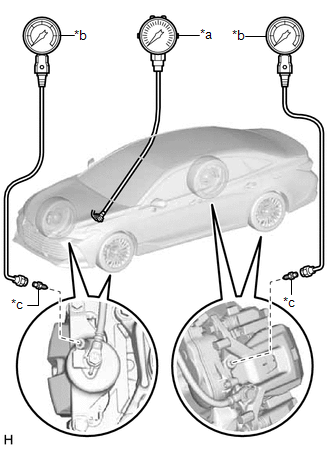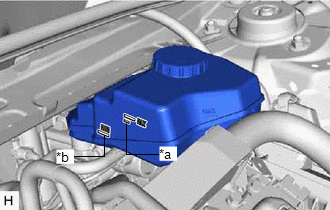On-vehicle Inspection
ON-VEHICLE INSPECTION
CAUTION / NOTICE / HINT
NOTICE:
DTCs
may be stored during the inspection procedure. Be sure to clear the
DTCs and check that no DTCs are output after the inspection is finished.
PROCEDURE
1. INSPECT PRESSURE SENSOR
(a) Check auxiliary battery voltage.
Standard Voltage:
11 to 14 V (while the power switch is off)
(b) Set a pedal effort gauge and SST, and connect the Techstream.
| (1) Set a pedal effort gauge and SST. SST: 09709-29018
09709-00060 |
 |
|
*a | Pedal Effort Gauge | |
*b | SST (LSPV Gauge) | |
*c | SST (No. 1 Nipple) | | |
(2) Connect the Techstream to the DLC3 with the power switch off, the shift lever in P and the parking brake applied.
(3) Turn the power switch on (IG) and turn the Techstream on.
(4) Bleed air from SST (LSPV gauge).
Click here 
(c) Inspect the reaction force pressure and servo pressure.
(1) Enter the following menus: Chassis / ABS/VSC/TRAC / Data List / Reaction Force Pressure and Servo Pressure.
Chassis > ABS/VSC/TRAC > Data List
|
Tester Display |
| Reaction Force Pressure |
|
Servo Pressure |
(2) Check the value output from "Reaction Force Pressure" and "Servo Pressure" by depressing the brake pedal.
Standard Result:
|
Pedal Effort | Reaction Force Pressure
(MPa) | Servo Pressure
(MPa) | Front Right Wheel Hydraulic Pressure |
Rear Left Wheel Hydraulic Pressure |
|
50 N (5 kgf, 11.2 lbf) |
0.04 to 0.84 | 3.42 to 4.02 |
1.42 to 5.42 MPa (14.4 to 55.2 kgf/cm2, 206 to 786 psi) |
1.42 to 5.42 kPa (14.4 to 55.2 kgf/cm2, 206 to 786 psi) |
|
100 N (10 kgf, 22.5 lbf) |
0.66 to 1.46 | 5.98 to 6.58 |
3.98 to 7.98 MPa (40.5 to 81.3 kgf/cm2, 577 to 1157 psi) |
3.98 to 7.98 kPa (40.5 to 81.3 kgf/cm2, 577 to 1157 psi) |
|
150 N (15 kgf, 33.7 lbf) |
1.28 to 2.08 | 8.55 to 9.15 |
6.55 to 10.55 MPa (66.8 to 107.5 kgf/cm2, 950 to 1530 psi) |
6.55 to 10.55 kPa (66.8 to 107.5 kgf/cm2, 950 to 1530 psi) |
|
200 N (20 kgf, 45.0 lbf) |
1.90 to 2.70 | 10.57 to 11.17 |
8.57 to 10.8 MPa (87.5 to 110.2 kgf/cm2, 1243 to 1566 psi) |
8.57 to 10.8 kPa (87.5 to 110.2 kgf/cm2, 1243 to 1566 psi) |
Standard Result:
|
Pedal Effort | Reaction Force Pressure
(MPa) | Servo Pressure
(MPa) | Front Left Wheel Hydraulic Pressure |
Rear Right Wheel Hydraulic Pressure |
|
50 N (5 kgf, 11.2 lbf) |
0.04 to 0.84 | 3.42 to 4.02 |
1.42 to 5.42 kPa (14.4 to 55.2 kgf/cm2, 206 to 786 psi) |
1.42 to 5.42 kPa (14.4 to 55.2 kgf/cm2, 206 to 786 psi) |
|
100 N (10 kgf, 22.5 lbf) |
0.66 to 1.46 | 5.98 to 6.58 |
3.98 to 7.98 MPa (40.5 to 81.3 kgf/cm2, 577 to 1157 psi) |
3.98 to 7.98 kPa (40.5 to 81.3 kgf/cm2, 577 to 1157 psi) |
|
150 N (15 kgf, 33.7 lbf) |
1.28 to 2.08 | 8.55 to 9.15 |
6.55 to 10.55 MPa (66.8 to 107.5 kgf/cm2, 950 to 1530 psi) |
6.55 to 10.55 kPa (66.8 to 107.5 kgf/cm2, 950 to 1530 psi) |
|
200 N (20 kgf, 45.0 lbf) |
1.90 to 2.70 | 10.57 to 11.17 |
8.57 to 10.8 MPa (87.5 to 110.2 kgf/cm2, 1243 to 1566 psi) |
8.57 to 10.8 kPa (87.5 to 110.2 kgf/cm2, 1243 to 1566 psi) |
(d) Remove the pedal effort gauge and SST.
(1) Remove the pedal effort gauge and SST, and bleed the brake line.
Click here 
(e) Inspect the accumulator pressure.
(1) Enter the following menus: Chassis / ABS/VSC/TRAC / Data List / Accumulator Pressure and MT Voltage Value.
Chassis > ABS/VSC/TRAC > Data List
|
Tester Display |
| MT Voltage Value |
|
Accumulator Pressure |
(2) While fully depressing the brake pedal 4 or 5 times, check that the MT voltage value is 10 V or more once or more.
HINT:
Usually the MT voltage value is 0 V.
(3) After confirming that the booster pump motor stops, check the accumulator pressure.
Standard Result:
15 to 21 MPa
2. INSPECT BRAKE BOOSTER WITH MASTER CYLINDER ASSEMBLY
(a) Check auxiliary battery voltage.
Standard Voltage:
11 to 14 V (while the power switch is off)
(b) Set a pedal effort gauge and SST, and connect the Techstream.
| (1) Set a pedal effort gauge and SST. SST: 09709-29018
09709-00060 |
 |
|
*a | Pedal Effort Gauge | |
*b | SST (LSPV Gauge) | |
*c | SST (No. 1 Nipple) | | |
(2) Connect the Techstream to the DLC3 with the power switch off, the shift lever in P and the parking brake applied.
(3) Turn the power switch on (IG) and turn the Techstream on.
(4) Clear the DTCs.
Click here 
(5) Bleed air from SST (LSPV gauge).
Click here 
(c) Check operation without the brake booster.
(1) Inspect and adjust the brake pedal height.
Click here

| (2) Adjust the brake fluid level of the reservoir so that it is between the MIN line and fluid level support line. |
 |
|
*a | Fluid Level Support Line | |
*b | MIN Line | | |
(3)
Turn the Techstream on and enter the following menus: Chassis /
ABS/VSC/TRAC / Utility / ECB (Electronically Controlled Brake system)
Utility.
Chassis > ABS/VSC/TRAC > Utility
|
Tester Display |
| ECB Utility |
(4) Select "Motor Invalid" on the "ECB (Electronically Controlled Brake system) Utility" screen.
(5) Perform "Motor Invalid" according to the display on the Techstream.
(6) Depress the brake pedal 40 times or more to return all the fluid in the accumulator back to the reservoir.
HINT:
A buzzer may sound due to low accumulator pressure. As this is not a malfunction, continue the procedure.
(7) Check that the brake pedal is firm.
(8) Enter the following menus: Chassis / ABS/VSC/TRAC / Data List / Stroke Sensor and Stroke Sensor 2.
Chassis > ABS/VSC/TRAC > Data List
|
Tester Display |
| Stroke Sensor |
|
Stroke Sensor2 |
(9) Check the values output from "Stroke Sensor" and "Stroke Sensor 2" by depressing the brake pedal.
Standard Result:
|
Pedal Effort | Stroke Sensor
(V) | Stroke Sensor 2
(V) | Front Right Wheel Hydraulic Pressure |
Rear Left Wheel Hydraulic Pressure |
|
200 N (20 kgf, 45.0 lbf) |
1.52 to 2.22 | 2.78 to 3.48 |
0.04 to 2.04 MPa (0.36 to 20.76 kgf/cm2, 6 to 296 psi) |
0.04 to 2.04 MPa (0.36 to 20.76 kgf/cm2, 6 to 296 psi) |
|
500 N (51 kgf, 112.4 lbf) |
1.81 to 2.51 | 2.49 to 3.19 |
2.06 to 4.06 MPa (21.0 to 41.4 kgf/cm2, 299 to 589 psi) |
2.06 to 4.06 MPa (21.0 to 41.4 kgf/cm2, 299 to 589 psi) |
Standard Result:
|
Pedal Effort | Stroke Sensor
(V) | Stroke Sensor 2
(V) | Front Left Wheel Hydraulic Pressure |
Rear Right Wheel Hydraulic Pressure |
|
200 N (20 kgf, 45.0 lbf) |
1.52 to 2.22 | 2.78 to 3.48 |
0.04 to 2.04 MPa (0.36 to 20.76 kgf/cm2, 6 to 296 psi) |
0.04 to 2.04 MPa (0.36 to 20.76 kgf/cm2, 6 to 296 psi) |
|
500 N (51 kgf, 112.4 lbf) |
1.81 to 2.51 | 2.49 to 3.19 |
2.06 to 4.06 MPa (21.0 to 41.4 kgf/cm2, 299 to 589 psi) |
2.06 to 4.06 MPa (21.0 to 41.4 kgf/cm2, 299 to 589 psi) |
(10) Remove the pedal effort gauge and SST, and bleed the brake system.
Click here 
(11) Enter the following menus: Chassis / ABS/VSC/TRAC / Data List / Accumulator Pressure, and check the output pressure.
Chassis > ABS/VSC/TRAC > Data List
|
Tester Display |
| Accumulator Pressure |
Standard Result:
15 to 21 MPa
(12) Clear the DTCs.
Click here

3. INSPECT STROKE SIMULATOR
(a) Check auxiliary battery voltage.
Standard Voltage:
11 to 14 V (while the power switch is off)
(b) Connect the Techstream and set a pedal effort gauge.
(1) Set a pedal effort gauge.
(2) Connect the Techstream to the DLC3 with the power switch off, the shift lever in P and the parking brake applied.
(3) Turn the power switch on (IG) and turn the Techstream on.
(4) Clear the DTCs.
Click here 
(c) Check operation with the brake booster.
(1) Turn the power switch on (IG).
(2) Enter the following menus: Chassis / ABS/VSC/TRAC / Data List / Stroke Sensor and Stroke Sensor 2.
Chassis > ABS/VSC/TRAC > Data List
|
Tester Display |
| Stroke Sensor |
|
Stroke Sensor2 |
(3) Depress the brake pedal 4 or 5 times.
(4) Check the values output from "Stroke Sensor" and "Stroke Sensor 2" by depressing the brake pedal.
Standard Voltage:
|
Pedal Effort | Stroke Sensor
(V) | Stroke Sensor 2
(V) |
| 50 N (5 kgf, 11.2 lbf) |
1.33 to 2.03 | 2.97 to 3.67 |
|
100 N (10 kgf, 22.5 lbf) |
1.51 to 2.21 | 2.79 to 3.49 |
|
150 N (15 kgf, 33.7 lbf) |
1.63 to 2.33 | 2.67 to 3.37 |


































































